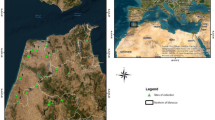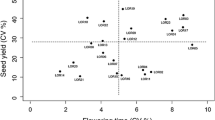Abstract
Leucaena leucocephala is an important agroforestry species pan-tropically, but relatively little is known of the forage production potential of other species in the genus. The agronomic potential of 116 accessions, represent ing the 28 species and subspecies of the Leucaena genus and several artificial hybrid accessions, was evaluated at Los Baños, Philippines and Brisbane, Australia over a 2.5–year period. Accessions were planted into replicated line plots, with 10 trees/plot spaced 50 cm apart, and with rows spaced 3 m apart. The L. pallida × L. leuco cephala KX2 F 1 hybrid accessions were highest yielding at both sites, producing dry matter (DM) yields of over 900 g/m row/month at Los Baños and approximately 320 g/m row/month at Brisbane. In the near-optimal growth conditions at Los Baños, L. leucocephala accessions were highly productive, with the best accessions producing total yields of over 500 g/m row/month. The superiority of KX2 hybrids was most pronounced at Brisbane, where high psyllid pressure during summer, and low temperatures during winter severely constrained growth of L. leu cocephala accessions. In the Brisbane environment, psyllid resistant accessions of L. pallida , L. trichandra and L. diversifolia were more productive than L. leucocephala accessions. Leucaena greggii , L. retusa , L. cuspidata , L. confertiflora , L. pulverulenta , L. pueblana and L. involucrata were of inherently low productivity in both the Brisbane and Los Baños environments. Mortality over the experimental period was very low for most species, particularly for L. leucocephala and KX2 accessions. The KX2 F1 hybrid accessions have considerable agro nomic potential as alternatives to L. leucocephala for use in tropical agroforestry.
Similar content being viewed by others
References
Argel P.J. and Perez G.1998. Adaptation of new species of Leucaena in Costa Rica, Central America-Preliminary results. In: Shelton H.M., Gutteridge R.C., Mullen B.F. and Bray R.A. (Eds.), Leucaena-Adaptation, Quality and Farming Systems. Proceedings of a workshop held in Hanoi, Vietnam 9–14 February 1998. ACIAR, Canberra, Australia. pp. 146–149.
Austin M.T., Williams M.J., Hammond A.C., Frank J.H. and Chambliss C.G.1995. Establishment, forage production, and nutritive value of Leucaena in Central Florida. Agronomy Journal87: 915–920.
Austin M.T., Early R.J., Brewbaker J.L. and Sun W.1997. Yield, psyllid resistance, and phenolic concentration of Leucaena in two environments in Hawaii. Agronomy Journal89: 507–515.
Austin M.T., Sun W., Brewbaker J.L. and Schifino-Wittman M.T.1998. Developing Leucaena hybrids for commercial use. In: Shelton H.M., Gutteridge R.C., Mullen B.F. and Bray R.A. (Eds.), Leucaena-Adaptation, Quality and Farming Systems. Proceedings of a workshop held in Hanoi, Vietnam 9–14 February 1998. ACIAR, Canberra, Australia. pp. 82–85.
Bray R.A. and Woodroffe T.D.1988. Resistance of some Leucaena species to the leucaena psyllid. Tropical Grasslands22: 11–16.
Bray R.A., Cooksley D.G., Hall T.J. and Ratcliff D.1988. Performance of fourteen Leucaena lines at five sites in Queen sland. Australian Journal of Experimental Agriculture28: 69–76.
Castillo A.C., Acasio R.N., Victorio E.E., Moog F.A. and Palis R.1998. Agronomic performance of new Leucaena species and hy brids in the Philippines. In: Shelton H.M., Gutteridge R.C., Mullen B.F. and Bray R.A. (Eds.), Leucaena-Adaptation, Quality and Farming Systems.Proceedings of a workshop held in Hanoi, Vietnam 9–14 February 1998. ACIAR, Canberra, Australia. pp. 116–119.
Castillo A.C., Cuyagan O.C., Fogarty S. and Shelton H.M.1997. Growth, psyllid resistance and forage quality of Leucaena leu cocephala, L. pallida, L. diversifolia and the F1 hybrid of L. leucocephala×L. pallida. TropicalGrasslands31: 188–200
Ella A., Jacobsen C., Stur W.W. and Blair G.1989. Effect of plant density an cutting frequency on the productivity of four tree le gumes. Tropical Grasslands23: 28–34.
Galgal K.K., Shelton H.M., Mullen B.F., and Komolong M.K.2000. Animal production potential of some new Leucaena geno types in the Markham Valley of Papua New Guinea. Australasian Journal of Science. 13: 242–245.
Glumac E.L., Felker P. and Reyes I.1987. A comparison of cold tolerance and biomass production in Leucaena leucocephala, L. pulverulenta and L. retusa. Forest Ecology and Management18: 251–271.
Hughes C.E.1998. Leucaena-A genetic resources handbook.Oxford Forestry Institute, Tropical Forestry Paper No. 37. Oxford, UK274 pp.
Hughes C.E. and Harris S.A.1995. Systematics of Leucaena: Recent findings and implications for breeding and conservation. In: Shelton H.M., Piggin C.M. and Brewbaker J.L., (Eds.), Leucaena-Opportunities and Limitations.Proceedings of an International Workshop held in Bogor Indonesia, 24–29 January 1994. ACIAR, Canberra, Australia. pp. 47–53.
Jones R.J.1998. Evaluation of Leucaena species in the dry tropics of N.E. Australia for yield and psyllid tolerance. In: Shelton H.M., Gutteridge R.C., Mullen B.F. and Bray R.A. (Eds.), Leucaena-Adaptation, Quality and Farming Systems. Proceedings of a workshop held in Hanoi, Vietnam 9–14 February 1998. ACIAR, Canberra, Australia. pp. 157–162.
Komolong M., Mullen B.F., Bino B., Tarabu J. and Galgal K.K.1998. Germplasm evaluation of new leucaenas in Papua New Guinea. In: Shelton H.M., Gutteridge R.C., Mullen B.F. and Bray R.A. (Eds.), Leucaena-Adaptation, Quality and Farming Systems. Proceedings of a workshop held in Hanoi, Vietnam 9–14 February 1998. ACIAR, Canberra, Australia. pp. 123–127.
Middleton C.H. and Clem R.1998. Evaluation of Leucaena germ plasm on clay soils in southern and central inland Queensland. In: Shelton H.M., Gutteridge R.C., Mullen B.F. and Bray R.A. (Eds.), Leucaena-Adaptation, Quality and Farming Systems. Proceedings of a workshop held in Hanoi, Vietnam 9–14 February 1998. ACIAR, Canberra, Australia. pp. 154–156.
Mullen B.F.2001. Agronomic adaptation to environmental challenges in the genus Leucaena. PhD Thesis. The University of Queensland, Brisbane, Australia.
Mullen B.F., Gabunada F., Shelton H.M. and Stür W.W. (a) (in press). Psyllid resistance in Leucaena. Part 1. Genetic resistance of the genus in subtropical Australia and humid-tropical Philip pines. Agroforestry Systems.
Mullen B.F., Shelton H.M., Gutteridge R.C. and Basford K.E. (b) submitted. Agronomic evaluation of Leucaena. Part 1. Adaptation to environmental challenges in multi-environment trials. Agroforestry Systems
Shelton H.M., Piggin C.M. and Brewbaker J.L.1995. Leucaena:-Opportunities and Limitations. Proceedings of a workshop held on Bogor, Indonesia 24–29 January 1994. ACIAR, Canberra, Australia.
Shelton H.M. and Brewbaker J.L.1994. L. leucocephala-the most widely used forage tree legume. In: Gutteridge R.C. and Shelton H.M. (Eds.), Forage Tree Legumes in Tropical Agriculture. CAB International, Wallingford, UK. pp. 15–29.
Shelton H.M., Norton B.W., Mullen B.F., Gutteridge R.C. and Dart P.J.1996. Utilization and nutritive value of Calliandra calothyrsus for forage: a review of research at the University of Queensland. In: Evans D.O. (Ed.), International Workshop on the Genus Calliandra, January 23–27, 1996. Bogor, Indonesia, Winrock International, Arkanas, USA. pp. 210–221.
Sorensson C.T.1995. Potential for improvement of Leucaena through interspecific hybridisation. In: Shelton H.M., Piggin C.M. and Brewbaker J.L. (Eds.), Leucaena:-Opportunities and Limitations. Proceedings of a workshop held on Bogor, Indonesia 24–29 January 1994. ACIAR, Canberra, Australia. pp. 47–53.
Wheeler R.A.1988. Leucaena psyllid trial at Waimanalo, Hawaii. Leucaena Research Reports8: 25–29.
Wheeler R.A. and Brewbaker J.L.1990. An evaluation of results from the Leucaena psyllid trial network. Leucaena Research Reports11: 23–31.
Wickremasinghe I.P. and Gunasena H.P.M.1998. Evaluation of sixteen Leucaena provenances for biomass production, drought tolerance and psyllid resistance in Sri Lanka. In: Shelton H.M., Gutteridge R.C., Mullen B.F. and Bray R.A. (Eds.), Leucaena-Adaptation, Quality and Farming Systems.Proceedings of a workshop held in Hanoi, Vietnam 9–14 February 1998. ACIAR, Canberra, Australia. pp. 120–122.
Author information
Authors and Affiliations
Corresponding author
Rights and permissions
About this article
Cite this article
Mullen, B., Gabunada, F., Shelton, H. et al. Agronomic evaluation of Leucaena. Part 2. Productivity of the genus for forage production in subtropical Australia and humid-tropical Philippines. Agroforestry Systems 58, 93–107 (2003). https://doi.org/10.1023/A:1026040631267
Issue Date:
DOI: https://doi.org/10.1023/A:1026040631267




